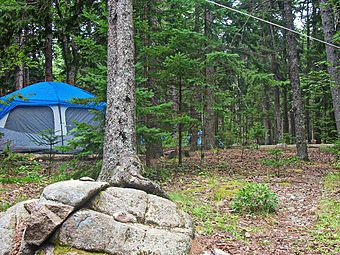Blackwoods Campground facts for kids
Quick facts for kids |
|
|
Blackwoods Campground
|
|

A campsite at Blackwoods
|
|
| Nearest city | Bar Harbor, Maine |
|---|---|
| Area | 160 acres (65 ha) |
| Built | 1935 |
| Built by | Civilian Conservation Corps et.al. |
| Architectural style | Historic Campground |
| MPS | Acadia National Park MPS |
| NRHP reference No. | 07000612 |
| Added to NRHP | June 29, 2007 |
Blackwoods Campground is a popular place to camp in Acadia National Park. It's found on the east side of Mount Desert Island in Maine. This campground offers a fun way to experience nature.
Workers from the Civilian Conservation Corps (CCC) started building Blackwoods in 1935. The CCC was a group that helped build parks and other public places. The campground looked mostly like it does today by 1961. It has 306 individual campsites and some spots for groups. You can find fresh water and restrooms here, but no showers or electric hookups. Many people book their campsites up to six months ahead of time. The older part of the campground, built by the CCC, was added to the National Register of Historic Places in 2007.
Contents
Exploring Blackwoods Campground
Acadia National Park is a beautiful park located on Mount Desert Island. This island is just off the coast of central Maine. The island has two main parts, separated by a narrow waterway called Somes Sound. Blackwoods Campground is located near the very southeastern tip of the eastern part of the island. You can easily get there from Maine State Route 3.
The campground has a winding road that leads you from Route 3 to the main office. This is where you check in when you arrive. From the main office, the campground spreads out into different areas.
Campsite Layout and Facilities
Blackwoods Campground is divided into different sections, often called "loops."
- Loop A is to the west of the main office. It has about 160 campsites. This number can change a bit over time. Loop A also has six "comfort stations," which are buildings with restrooms.
- Loop B is located to the north. It has around 140 campsites and five comfort stations.
Between Loop A and Loop B, there's an amphitheater. This is a special outdoor area where park rangers lead fun activities and talks. There's also a short path from Loop A that goes down towards the ocean shore. The park's main loop road runs between the campground and the shore. The water for the campground comes from a large tank located north of Loop B.
The Story of Blackwoods Campground
Acadia National Park first started in 1916. Back then, it was called the Sieur de Monts National Monument. In the 1920s, park planners decided that campgrounds were important. This was because camping was becoming very popular.
Early Campground Development
Between 1927 and 1932, the park built its first campground, called Beark Brook. More money for other campgrounds didn't come until the 1930s. This is when the Civilian Conservation Corps (CCC) was created. The CCC helped people find jobs and also improved parks across the country.
Money to build Blackwoods Campground was approved in 1936. The land for Blackwoods was given to the park by John D. Rockefeller Jr.. A team from the CCC looked at the area and drew up a plan. This plan included the main office area and three loops with 400 campsites. The design was very modern for its time. It even included spots for trailer camping, which was a new idea back then.
Building the Campground
From 1938 to 1942, the CCC built the main camp road, the central office area, and 100 campsites in Loop A. However, the check-in station wasn't finished. This was because the United States joined World War II.
After the war ended, more comfort stations were added. An amphitheater was also built, though the one you see today was built later in 1975. Loop B was built in the 1960s. This was part of a special program to celebrate the 50th anniversary of the National Park Service.
Since then, Blackwoods Campground has changed only a little bit. The road leading to it was made wider. A new check-in station was built in 1978 after the old one was destroyed by a fire. The number of campsites has changed over the years. Some new sites have been added, while others have been removed or combined. The third loop that was planned a long time ago has not been built.



